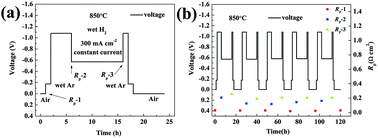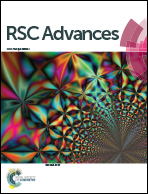A Gd0.2Ce0.8O1.9 impregnated Pr0.4Sr0.6Co0.2Fe0.7Nb0.1O3−δ nanofiber-structured composite anode in solid oxide fuel cells
Abstract
In this study, comparative experiments were conducted based on La0.8Sr0.2Ga0.8Mg0.2O3−δ (LSGM) electrolytes, which supported single solid oxide fuel cells (SOFCs) with pure nanofiber-structured Pr0.4Sr0.6Co0.2Fe0.7Nb0.1O3−δ (PSCFN) anodes or Gd0.2Ce0.8O1.9 (GDC) impregnated PSCFN nanofiber-structured composite anodes. The polarization resistance (Rp) values of the pure nanofiber-structured PSCFN anode and the PSCFN–GDC nanofiber-structured composite anode with an optimal mass ratio of 1 : 0.56 were recorded as 1.573 Ω cm2 and 0.212 Ω cm2 at 850 °C in wet H2 (97% H2–3% H2O), respectively. After impregnating the GDC materials, the maximum power density (Pmax) of the single cell with the PSCFN–GDC nanofiber-structured composite anode was found to be about 1.5 times greater than that of the pure nanofiber-structured PSCFN anode at 850 °C in wet H2. The cell with the PSCFN–GDC nanofiber-structured composite anode presented a significant electrochemical performance in wet H2. Meanwhile it also showed excellent thermal cycling and long-term stability during the redox and constant-current discharge testing (300 mA cm−2) at 850 °C in wet H2. All of these results indicated that the PSCFN–GDC nanofiber-structured composite anode acted as an efficient and competitive power anode operating in hydrogen fuels.


 Please wait while we load your content...
Please wait while we load your content...